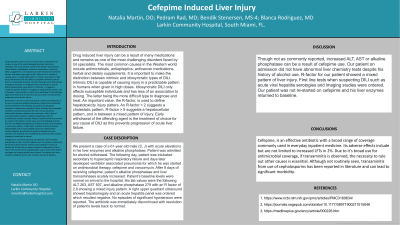Back


Poster Session A - Sunday Afternoon
Category: Liver
A0519 - Cefepime-Induced Liver Injury
Sunday, October 23, 2022
5:00 PM – 7:00 PM ET
Location: Crown Ballroom

Has Audio

Natalia Martin, DO
Larkin Community Hospital
South Miami, FL
Presenting Author(s)
Natalia Martin, DO, Pedram Rad, MD, Bendik Stenersen, OMS-4, Blanca Rodriguez, MD
Larkin Community Hospital, South Miami, FL
Introduction: Drug induced liver injury can be a result of many medications and remains as one of the most challenging disorders faced by GI specialists. The most common causes in the Western world include antimicrobials, antiepileptics, anticancer medications, herbal and dietary supplements. It is important to make the distinction between intrinsic and idiosyncratic types of DILI. Intrinsic DILI is capable of causing injury in a predictable pattern in humans when given in high doses. Idiosyncratic DILI only affects susceptible individuals and has less of an association to dosing. The latter being the more difficult type to diagnose and treat. An important value, the R-factor, is used to define hepatotoxicity injury patters. An R-factor < 2 suggests a cholestatic pattern, R-factor > 5 suggests a hepatocellular pattern, and in between a mixed pattern of injury. Early withdrawal of the offending agent is the treatment of choice for any cause of DILI as this prevents progression of acute liver failure.
Case Description/Methods: We present a case of a 61 year old male (S, J) with acute elevations in his liver enzymes and alkaline phosphatase. Patient was admitted for alcohol withdrawal. The following day, patient was intubated secondary to hypercapnic respiratory failure and days later developed ventilator associated pneumonia for which he was started on antimicrobial therapy, cefepime and vancomycin. After 9 days of receiving cefepime, patient’s alkaline phosphatase and liver transaminases acutely increased. Patient’s baseline levels were normal on arrival to the hospital. His lab values were the following: ALT 263, AST 507, and alkaline phosphatase 279 with an R factor of 2.8 showing a mixed injury pattern. A right upper quadrant ultrasound showed hepatomegaly and an acute hepatitis panel was ordered which resulted negative. No episodes of significant hypotension were reported. The antibiotic was immediately discontinued with resolution of patient’s levels back to normal.
Discussion: Though not as commonly reported, increased ALT, AST or alkaline phosphatase can be a result of cefepime use. Our patient on admission did not have abnormal liver chemistry tests despite his history of alcohol use. R-factor for our patient showed a mixed pattern of liver injury. First line tests when suspecting DILI such as acute viral hepatitis serologies and imaging studies were ordered. Our patient was not re-started on cefepime and his liver enzymes returned to baseline.
Disclosures:
Natalia Martin, DO, Pedram Rad, MD, Bendik Stenersen, OMS-4, Blanca Rodriguez, MD. A0519 - Cefepime-Induced Liver Injury, ACG 2022 Annual Scientific Meeting Abstracts. Charlotte, NC: American College of Gastroenterology.
Larkin Community Hospital, South Miami, FL
Introduction: Drug induced liver injury can be a result of many medications and remains as one of the most challenging disorders faced by GI specialists. The most common causes in the Western world include antimicrobials, antiepileptics, anticancer medications, herbal and dietary supplements. It is important to make the distinction between intrinsic and idiosyncratic types of DILI. Intrinsic DILI is capable of causing injury in a predictable pattern in humans when given in high doses. Idiosyncratic DILI only affects susceptible individuals and has less of an association to dosing. The latter being the more difficult type to diagnose and treat. An important value, the R-factor, is used to define hepatotoxicity injury patters. An R-factor < 2 suggests a cholestatic pattern, R-factor > 5 suggests a hepatocellular pattern, and in between a mixed pattern of injury. Early withdrawal of the offending agent is the treatment of choice for any cause of DILI as this prevents progression of acute liver failure.
Case Description/Methods: We present a case of a 61 year old male (S, J) with acute elevations in his liver enzymes and alkaline phosphatase. Patient was admitted for alcohol withdrawal. The following day, patient was intubated secondary to hypercapnic respiratory failure and days later developed ventilator associated pneumonia for which he was started on antimicrobial therapy, cefepime and vancomycin. After 9 days of receiving cefepime, patient’s alkaline phosphatase and liver transaminases acutely increased. Patient’s baseline levels were normal on arrival to the hospital. His lab values were the following: ALT 263, AST 507, and alkaline phosphatase 279 with an R factor of 2.8 showing a mixed injury pattern. A right upper quadrant ultrasound showed hepatomegaly and an acute hepatitis panel was ordered which resulted negative. No episodes of significant hypotension were reported. The antibiotic was immediately discontinued with resolution of patient’s levels back to normal.
Discussion: Though not as commonly reported, increased ALT, AST or alkaline phosphatase can be a result of cefepime use. Our patient on admission did not have abnormal liver chemistry tests despite his history of alcohol use. R-factor for our patient showed a mixed pattern of liver injury. First line tests when suspecting DILI such as acute viral hepatitis serologies and imaging studies were ordered. Our patient was not re-started on cefepime and his liver enzymes returned to baseline.
Disclosures:
Natalia Martin indicated no relevant financial relationships.
Pedram Rad indicated no relevant financial relationships.
Bendik Stenersen indicated no relevant financial relationships.
Blanca Rodriguez indicated no relevant financial relationships.
Natalia Martin, DO, Pedram Rad, MD, Bendik Stenersen, OMS-4, Blanca Rodriguez, MD. A0519 - Cefepime-Induced Liver Injury, ACG 2022 Annual Scientific Meeting Abstracts. Charlotte, NC: American College of Gastroenterology.
